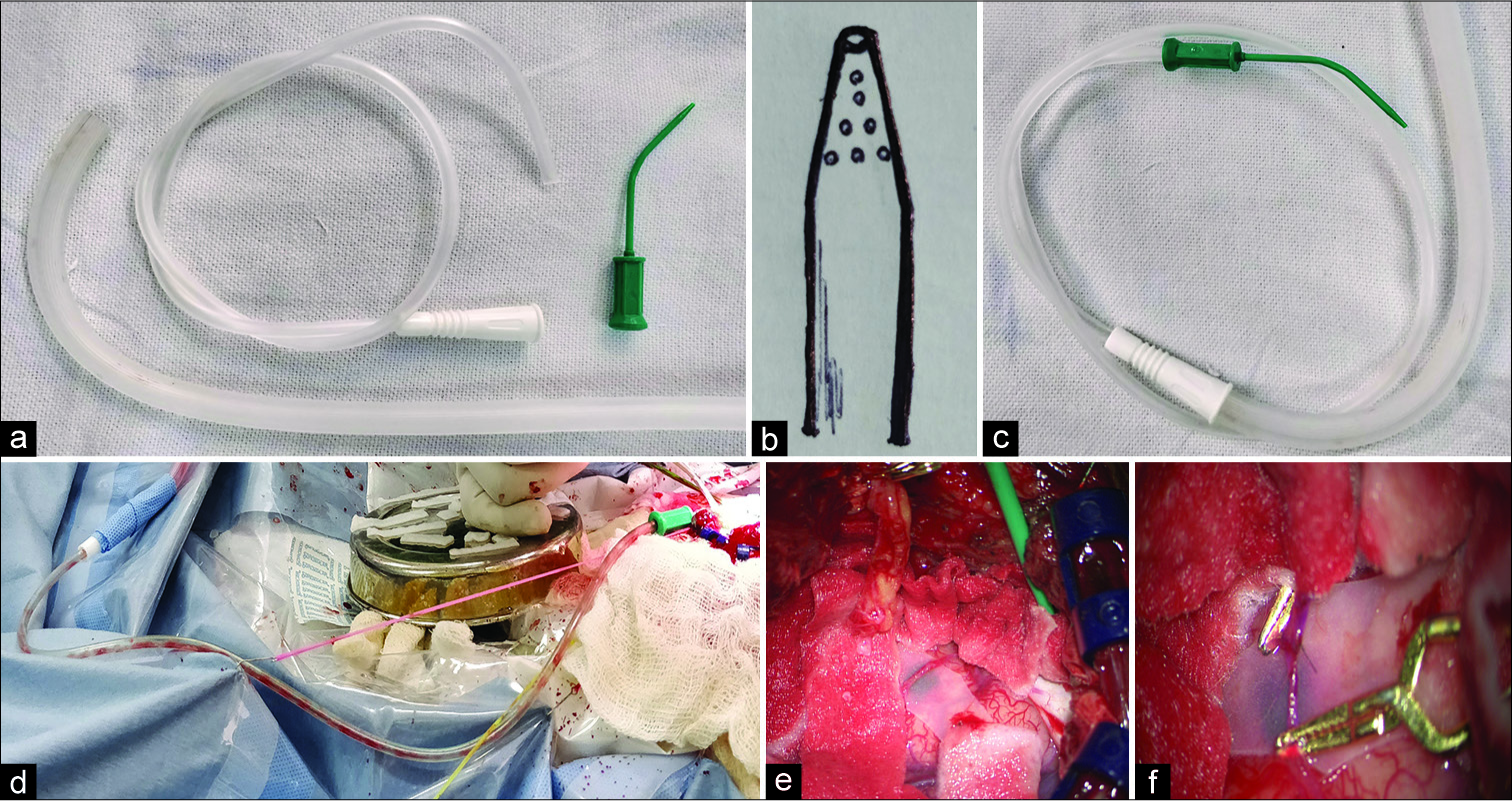- Department of Neurosurgery, Post Graduate Institute of Medical Education and Research, Chandigarh, India.
DOI:10.25259/SNI_170_2019
Copyright: © 2019 Surgical Neurology International This is an open-access article distributed under the terms of the Creative Commons Attribution-Non Commercial-Share Alike 4.0 License, which allows others to remix, tweak, and build upon the work non-commercially, as long as the author is credited and the new creations are licensed under the identical terms.How to cite this article: Kokkula Praneeth, Ashish Aggarwal, Sunil Kumar Gupta, Navneet Singla. Necessity is the mother of invention: Technical note on the use of self-designed low-cost continuous sump suction for use in microvascular anastomosis. 08-Nov-2019;10:216
How to cite this URL: Kokkula Praneeth, Ashish Aggarwal, Sunil Kumar Gupta, Navneet Singla. Necessity is the mother of invention: Technical note on the use of self-designed low-cost continuous sump suction for use in microvascular anastomosis. 08-Nov-2019;10:216. Available from: http://surgicalneurologyint.com/surgicalint-articles/9743/
Abstract
Background: Technical advances in microneurosurgery facilitated the continuous evolution of surgery. In many developing countries surgeons face difficulties rendering high quality services due to resource constraints. The continuous dry surgical field is essential for performing microvascular anastomosis. Commercially available sump suctions are costly and beyond the reach of most surgeons in resource-constrained countries.
Methods: We designed a suction system which functions on the principles of capillary action and sump effect.
Results: The improvised sump suction was used successfully in our patients for micro vascular surgery, giving us a continuous dry field and removing the chance of error by an assistant.
Conclusion: The suction system was made with the use of easily available low-cost components, and worked well to the satisfaction of the surgeon.
Keywords: Capillary sump suction, Microanastomosis, Sump suction
INTRODUCTION
It is difficult to imagine the marvels of modern microneurosurgery without concomitant technological advancements. However, universal availability of advanced technology and equipment is sometimes hindered by patent rights, approval from government-regulating bodies, and cost. In many developing countries, surgeons face trouble in rendering state-of-the-art modern patient care due to the resource constraints. This is despite the fact that the need and principles of surgery are universally same. We have designed a suction system which can be easily assembled with commonly available components and used with efficacy to provide continuous dry surgical field for microvascular anastomosis.
MATERIALS AND METHODS
This system was made using tissue dilator of pediatric central line, suction catheter, and suction tubing. [
Figure 1:
Panel a: Disposable suction tubung, dispoasble suction catheter and tissue dilator of pediatric central line. Panel b: Multiple small holes on the tissue dilator. Panel c: completed assembly . Panel d: Assembly placed near the operating site without interfering with the operative set up . Panel e: surgical site surrounded by cotton patties and the tip of tissue dilator placed over patties. Panel f: Resultant dry surgical field.
DISCUSSION
Microvascular anastomosis for intracranial vessels was first described by Yasargil in 1967.[
We describe a suction system which is made up of components which are easily available and can be simply assembled. The suction system can be placed away from the anastomosis site according to the ease of surgeon. Tip of the suction device and operative field is covered with cotton patties. Essential features of this suction system are that it is continuous, low-pressure suction which exploits capillary action of cotton patties.
Similar continuous suction device described by Koyama et al. in which a silicon catheter was placed outside the dura and was better suited to address extradural sources of blood. After the use of this system, the authors reported a significant reduction of anastomosis time.[
Our device system is placed inside the Dura. It not only addresses the small extradural bleeds but also helps in aspirating CSF and saline which is used intermittently. The advantages of our system are that it can be placed little away from anastomosis site thus obviating the danger of inadvertent pull on the anastomosis site. The blood, CSF, and saline can be easily sucked by a low-pressure continuous suction. This is achieved by capillary action of cotton patties. These patties make a continuous chain from the anastomosis site to suction tip.
Before the use of this suctioning system, we used to take the help of assistant surgeon intermittently doing suctioning in the field. Due to the magnification required for microvascular anastomosis, even small movements would disturb the operating surgeon. By using continuous capillary sump suction system, operating surgeon can perform microvascular anastomosis independently and reduces the ischemic time by reducing the time lost to clear the field. The present device utilizes the principle of capillary action, and surgeons can modify the elements of the device according to the availability.
CONCLUSION
The capillary sump suction system can be assembled with components which are easily available with low cost and facilitates microvascular anastomosis. This technique can be applied to microanastomosis of nerves and by other disciplines such as reconstructive surgery for free flap transfers.
Financial support and sponsorship
The costs associated with the publication of this article were covered by the James I. and Carolyn R. Ausman Educational Foundation.
Conflicts of interest
There are no conflicts of interest.
References
1. Koyama J, Tanaka Y, Iwashita T, Kitazawa K, Hongo K. Continuous suction method in superficial temporal artery-middle cerebral artery anastomosis surgery. Technical note. Neurol Med Chir (Tokyo). 2006. 46: 262-4
2. Spetzler RF, Nakaji P, Rhoton AL, Kawashima M.editorsColor Atlas of Cerebral Revascularization: Anatomy, Techniques, Clinical Cases. New York: Thieme Medical Publishers, Inc.; 2013. p. 45-
3. Yaşargil MG. A legacy of microneurosurgery: Memoirs, lessons, and axioms. Neurosurgery. 1999. 45: 1025-92








Jim Ausman
Posted December 1, 2019, 8:58 am
This is a very creative, practical, and inexpensive suction device. It is an example of how innovative ideas come from everyone, everywhere and not just the high income countries. Meticulous hemostasis in neurosurgery at every step of a surgical procedure is a fundamental principle that is key to success in all surgeries. It reduces operating time, blood loss, morbidity, and can eliminate the need for transfusions. This simple device can be helpful when needed.